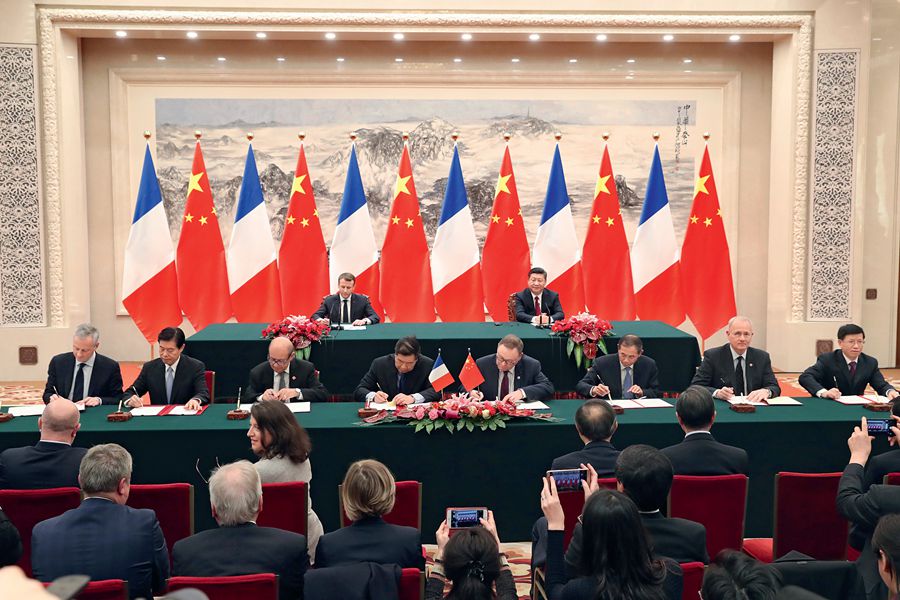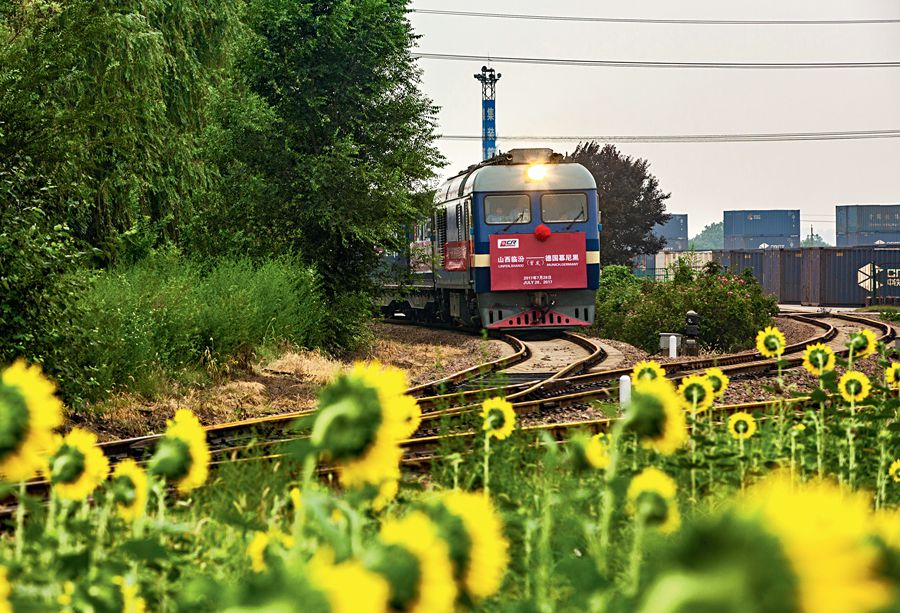THIRD-party market cooperation, an innovative new model for international cooperation devised by China, is intended to connect the competitive industrial capacity of China, advanced technologies of developed countries, and development needs of many emerging economies, and enhance the cooperative synergy of the three sides. Since its introduction, the tripartite cooperation model has been warmly received internationally as a successful attempt to build the Belt and Road. It also allows for China and developed countries to cooperate in providing the third country with top-level, highly competitive products and services, thus being beneficial to all, which makes the model compatible with the development trend of the times.
The new model is important for China to upgrade its industrial sector, for developing countries to promote their industrialization and fuel economic development, and for developed countries to explore new territory for win-win cooperation. It contributes to jointly building a community with a shared future along the Belt and Road.
New Impetus
The world economy is now still crippled by problems like unbalanced development, the widening gap between the rich and the poor, and antagonism between different social groups. Thus, economic globalization has been inevitably accompanied by unstable and uncertain factors, which have put many countries at a crossroad of choices. However, the zero-sum game mentality has cramped reform of the global governance system and stunted sustained prosperity of the world economy. Third-party market cooperation serves as a paragon of international cooperation featuring mutual understanding and shared development. Under this model, the three related parties jointly cope with challenges and adopt necessary economic policies through consultation on an equal footing with all benefits shared.

Chinese President Xi Jinping meets visiting French President Emmanuel Macron on January 9, 2018 in Beijing. They witness the signing of cooperation agreements on a range of fields between the two sides.
Thirty years of rapid development has shaped China into a country with one of the most complete industrial sectors in the world, sitting at the core of the global industrial chain. However, it is still in the middle phase of industrialization with its technical level to be improved further in many industrial fields. Meanwhile, the vast number of developing countries are still in the infancy of industrialization with strong demands for infrastructure construction and industrial development, but curbed by their lack of technology and capital. Third-party market cooperation can help them acquire equipment and industrial production lines with better cost performance, boost local technology development, and cultivate local talents, thus meeting their needs for industrial development and upgrading their economic and social development levels.
Developed countries are facing the problem of inadequate endogenous impetus for economic growth due to the withering manufacturing sector and insufficient demands from overseas markets. Therefore, despite their possession of advanced technology and core equipment, developed countries can’t effectively tap into the market of the developing world, confined by the high cost caused by their inadequate domestic industrial capacity. Innovative third-party market cooperation can connect supplies and demands of countries in different development stages, integrating the high, middle, and low ends of the global industrial chain, thus generating new impetus for global economic growth and benefits to all sides.
China joins hands with developed countries in tapping into the market of developing countries, which can contribute to the forming of a reasonable and efficient global industrial pattern and upgrade the global industrial chain. This can be done by combining the quality industrial capacity and competitive equipment of China and the key technology and advanced equipment of developed countries to meet many developing countries’ needs for industrialization and urbanization.
A Close Bond
Meeting the needs of countries in different development stages, the creative model of tripartite cooperation has been well received by a multitude of developing and developed countries. Over the past two years, China has reached consensus on third-party market cooperation with a dozen developed countries including France, South Korea, Germany, Britain, Canada, Singapore, Belgium, and Portugal. In such fields as infrastructure, energy, environmental protection, and finance, they have carried out institutionalized cooperation and made substantial progress on a range of major projects.

A train coming from Linfen of China’s Shanxi Province pulls out of North Houma Railway Station bound for Munich of Germany.
The most outstanding achievements have been made in the fields of nuclear power and high-speed rail. In September 2016, China General Nuclear Power Corporation (CGN) signed an agreement with Electricite De France (EDF) for investment in nuclear power projects in the U.K. to build the Hinkley Point C (HPC) nuclear power station and the two follow-up projects Sizewell C (SZC) and Bradwell B (BRB). For the CGN-led BRB project, it’s proposed to deploy the Hualong One (HPR1000) technology. This cooperation became the first successful case for the model of tripartite cooperation.
In June 2016, China and Germany released the Fourth Round of China-Germany Intergovernmental Consultation Joint Communiqué, voicing their support for third-party market cooperation by CRRC and Siemens in the high-speed rail field as well as that by China Railway and Deutsche Bahn in operation and maintenance of bullet trains traveling between China and European countries.
Real cases have shown that third-party market cooperation is feasible and has bright prospects. Now the related parties are working on establishing a normalized working mechanism, forming a network connecting governments, enterprises, financial institutions, chambers of commerce, think tanks, and embassies, so as to share information about policies, laws, and projects in the third market. All these efforts will help the related countries to formulate detailed cooperation plans, focus on key projects, and establish an effective service platform for third-party market cooperation.
The tripartite cooperation model allows adequate and effective risk assessment beforehand, realizes efficient resource allocation involving abundant capital, quality capacity, core equipment, and key technologies, and promotes deep integration of markets of different countries, thus maximizing their common interests and benefiting all. Third-party market cooperation has the potential to effectively galvanize the slumping world economy in the wake of the international financial crisis. It can also efficiently allocate global resources, reshape the global division of labor, and advance the reform of global governance, thus bonding the related countries closely, and forming a community of a shared future.
Promising Prospects
Under the framework of the Belt and Road Initiative, third-party market cooperation promises bright prospects. First, following the principles of extensive consultation, joint contribution, and shared benefits, in the tripartite cooperation model, China and its partners can realize more efficient allocation of resources, including capital and technology in the third market, and promote deep integration of different markets, thus achieving shared benefits. Second, along the Belt and Road, countries and regions have different advantages. For example, China’s strength is shown in its production capacity and abundant capital, developed countries own advanced technologies, and a vast number of developing countries have a huge market of demands. Third-party market cooperation effectively connects the three sides, meeting their respective development needs.
The Asian Infrastructure Investment Bank and the Silk Road Fund established under the framework of the Belt and Road Initiative provide a capital guarantee for third-party market cooperation. At the Belt and Road Forum for International Cooperation held in May 2017, Chinese President Xi Jinping declared that China would further instill RMB 100 billion (about US $14.65 billion) to the Silk Road Fund and encourage financial institutions to conduct overseas RMB fund business with an estimated amount of RMB 300 billion (US $43.94 billion), providing financing support for the Belt and Road Initiative. The China Development Bank and Export-Import Bank of China will set up the Belt and Road multi-currency special lending schemes (US $36.6 billion and US $19 billion equivalent respectively) to support cooperation projects along the routes on infrastructure, industrial capacity, and finance.
In addressing the conundrum of sluggish global economic recovery, the tripartite cooperation model has propelled both the South-South and South-North cooperation. The new cooperation model is changing the traditional industrial pattern in which resource-abundant countries provide raw materials, and China manufactures the products to be consumed by the developed world. By connecting needs of countries in different development stages, the new cooperation model contributes to th-e integration of the high, middle, and low parts of the global industrial chain, not only generating new impetus for world economic growth, but providing new opportunities to countries to gain development and achieve shared benefits.
Currently, third-party market cooperation is promising bright prospects. Developing countries along the Belt and Road have a great need for infrastructure investment, which is the basic economic motive for cooperation. China’s cooperation with France in nuclear power, with Germany in high-speed rail, and with Canada in oil projects, is promoting the tripartite cooperation model. Meanwhile, China’s economic development and the advancement of the Belt and Road construction serve as a guarantee for the supply of capital, labor, and technologies in future cooperation.
By working together with developed countries and international organizations, China seeks to offer new ideas and public goods, and jointly explore the third-party market through inter-governmental cooperation and alliances between industrial giants. China is trying to present its plan on international cooperation and contribute Chinese wisdom while blazing new trails for cooperation and nurturing new economic growth points.
WU SIKE is China’s former special envoy to the Middle East.

